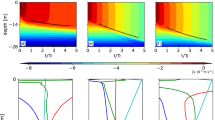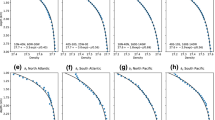Summary
Parameterisations of mixing induced through shear instability, internal wave breaking, and double diffusion are investigated in simulations of ocean climate using a global ocean general circulation model (OGCM). Focus is placed on the sensitivity of the large scale circulation, water mass formation and transport of heat as measures of the model's ability to represent current climate. The model resolution is typical of OGCMs being coupled to atmospheric. GCMs in climate models and the parameterisations investigated are all computationally inexpensive enough to allow for integrations on long time scales. Under the assumption of constant vertical eddy coefficients (the control case), the model climatology displays acceptable values of North Atlantic Deep Water formation, Antarctic Circumpolar Current (ACC) transport, and Indonesian through-flow but an excessively deep and diffuse pycnocline structure with weak stratification in the deep ocean. It is found that various circulation and water mass properties are sensitive to the choice of parameterisation of vertical mixing and that determining a scheme which works satisfactorily over all regions (tropical, mid-latitude, and polar) of the domain is not straightforward. Parameterisations of internal wave breaking or upper ocean shear instability lead to some improvements in the model water mass formation. ACC and poleward heat transport when compared to the control case whereas parameterisations of double diffusive processes did not. Based on these and other results, various recommendations are made for mixing parameterisations in ocean climate models.
Similar content being viewed by others
References
Broecker, W. S., 1991: The great ocean conveyor,Oceanography,4, 79–89.
Bryan, F., 1987: Parameter sensitivity of primitive equation ocean general circulation models.J. Phys. Oceanogr.,17, 970–985.
Bryan, K., 1969: A numerical method for the study of the circulation of the world ocean.J. Computat. Phys.,4, 347–376.
Bryan, K., 1984: Accelerating the convergence to equilibrium of ocean-climate models.J. Phys. Oceanogr. 14, 666–673.
Bryan, K., Lewis, L. J., 1979: A water mass model of the world ocean.J. Geophys. Res.,84, 2503–2517.
Cox, M. D., 1987: Isopycnal diffusion in a z-coordinate ocean model.Ocean Modelling,74, 1–5.
Cox, M. D., 1989: An idealised model of the world ocean. Part I: The global scale water masses.J. Phys. Oceanogr. 19, 1730–1752.
Cummins, P. F., Holloway, G., Gargett, A. E., 1990: Sensitivity of the GFDL ocean general circulation model to a parameterization of vertical diffusion.J. Phys. Oceanogr.,20, 817–830.
Danabasoglu, G., McWilliams, J. C., 1995: Sensitivity of the global ocean circulation to parameterization of mesoscale tracer transports.J. Climate,8, 2967–2987.
Esbensen, S. K., Kushnir, Y., 1981: The heat budget of the global ocean: an atlas based on estimates from surface marine observations.Oregon State University Climate Research Institute Report,29, 27pp.
Fieux, M. C., Delecluse, P., Ilahude, A. G., Kartavtseff, A., Mantisi, F., Molcard, R., Swallow, J. C., 1994: Measurements within the Pacific-Indian oceans throughflow region.Deep-Sea Res.,41, 1091–1130.
Gargett, A. E., Holloway, G., 1984: Dissipation and diffusion by internal wave breaking.J. Mar. Res.,42, 359–393.
Gent, P. R., McWilliams, J. C., 1990: Isopycnal mixing in ocean circulation models.J. Phys. Oceanogr.,20, 150–155.
Godfrey, J. S., 1989. A Sverdrup model of the depthintegrated flow for the world ocean allowing for island circulations.Geophys. Astrophys. Fluid Dynamics,45, 89–112.
Gordon, A. L., 1986: Interocean exchange of thermocline water.J. Geophys. Res.,91, 5037–5046.
Greatbatch, R. J., Fanning, A. F., Goulding, A. D., Levitus, S., 1991: A diagnosis of interpentadal circulation changes in the North Atlantic.J. Geophys. Res.,96/C12, 22009–22023.
Hellerman, S., Rosenstein, M., 1983: Normal monthly windstress over the world ocean with error estimates.J. Phys. Oceanogr.,13, 1093–1104.
Henderson-Sellers, B., 1985: New formulation of eddy diffusion thermocline models.Appl. Math. Model.,9, 441–446.
Hirst, A. C., Cai, W., 1994: Sensitivity of a world ocean GCM to changes in subsurface mixing parameterization.J. Phys. Oceanogr.,24, 1256–1279.
Holland, W. R., 1973: Baroclinic and topographic influences on the transport in western boundary currents.Geophys. Fluid. Dyn.,4, 187–210.
Kraus, E. B., 1990: Diapycnal mixing. In: Schlesinger, M. E. (ed.),Climate-Ocean Interaction, Netherlands: Kluwer, pp. 269–293.
Large, W. G., McWilliams, J. C., Doney, S. C., 1995: Oceanic vertical mixing: a review and a model with a nonlocal boundary layer parameterization.Rev. Geophys., (in press).
Levitus, S., 1982: Climatological atlas of the world ocean.NOAA Professional Paper,13, U.S. Govt. Printing Office, 173pp.
Mertz, G., Wright, D. G., 1992: Interpretations of the JEBAR term.J. Phys. Oceanogr.,22, 301–305.
Molinari, R. L., Fine, R. A., Johns, E., 1992: The deep western boundary current in the tropical North Atlantic Ocean.Deep-Sea Res.,39: 1967–1984.
Moore, A. M., Gordon, H. B., 1994: An investigation of climate drift in a global coupled ocean-atmosphere-sea-ice model.Clim. Dyn.,10, 81–96.
Moore, A. M., Reason, C. J. C., 1993: The response of a global ocean general circulation model to climatological surface boundary conditions for temperature and salinity.J. Phys. Oceanogr.,23, 300–328.
Myers, P. G., Fanning, A. F., Weaver, A. J., 1995: JEBAR, bottom pressure torque and Gulf Stream separation.J. Phys. Oceanogr., (accepted).
Nowlin, W. D., Jr., Klinck, J. M., 1986: The physics of the Antarctic Circumpolar Current.Rev. Geophys.,24, 469–491.
Pacanowski, R. C., Dixon, K., Rosati, A., 1991: The GFDL modular ocean model users guide, version 1.0GFDL Ocean Group Technical Report No. 2, Princeton University.
Pacanowski, R. C., Philander, S. G. H., 1981: Parameterization of vertical mixing in numerical models of tropical oceans.J. Phys. Oceanogr.,11, 1443–1451.
Price, J. F., Weller, R. A., Pinkel, R., 1986: Diurnal cycling: observations and models of the upper ocean response to diurnal heating, cooling, and wind mixing.J. Geophys. Res.,91/C7, 8411–8427.
Reason, C. J. C., Kuhnel, I., Henderson-Sellers, B., 1993: A comparison of vertical mixing schemes embedded in an OGCM with application to air-sea interactions and the evolution of SST anomalies.Meteorol. Atmos. Phys.,51, 55–71.
Reason, C. J. C., 1995: Comparison of vertical mixing schemes embedded in a global ocean GCM. Part II: Large scale circulation and water mass formation.Meterol. Atmos. Phys.,58, 51–63.
Redi, M. H., 1982: Oceanic isopycnal mixing by coordinate rotation.J. Phys. Oceanogr.,12, 1154–1158.
Semtner, A. J., Jr., Chervin, R. M., 1992: Ocean general circulation from a global eddy-resolving model.J. Geophys. Res.,97, 5493–5550.
Trenberth, K. E., Solomon, A., 1994: The global heat balance: heat transports in the atmosphere and the ocean.Clim. Dyn.,10, 107–134.
Troen, I. B., Mahrt, L., 1986: A simple model of the atmospheric boundary layer sensitivity to surface evaporation.Bound-Layer Meteor.,37, 129–148.
Whitworth, T., III, 1983: Monitoring the transport of the Antarctic Circumpolar Current at Drake Passage.J. Phys. Oceanogr.,13, 2045–2057.
Whitworth, T., III, Peterson, R. G., 1985: Volume transport of the Antarctic Circumpolar Current from bottom pressure measurements.J. Phys. Oceanogr.,15, 810–816.
Author information
Authors and Affiliations
Additional information
With 8 Figures
Rights and permissions
About this article
Cite this article
Reason, C.J.C. Stability dependent parameterisations of vertical mixing in ocean general circulation models. Meteorl. Atmos. Phys. 61, 1–18 (1996). https://doi.org/10.1007/BF01029707
Received:
Issue Date:
DOI: https://doi.org/10.1007/BF01029707




